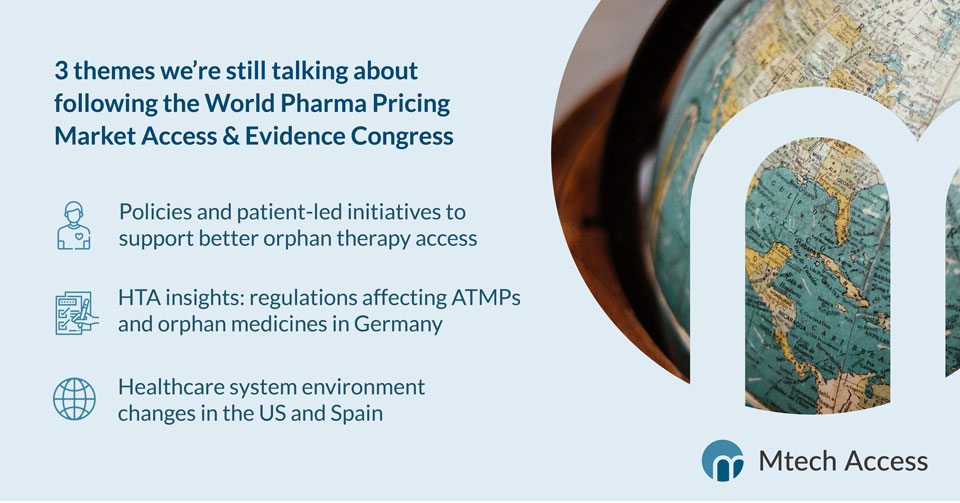
Mtech Access attended the virtual World Pharma Pricing Market Access & Evidence Congress on 23–25th September 2020, where our team were inspired by the range of seminars, round tables and presentations given by leading experts from the healthcare, life science, and pharmaceutical sectors. Since the congress, our market access team have been sharing some of their key takeaways. Here, we outline three areas of discussion which really prompted our interest.
1) Policies and patient-led initiatives to support better access to orphan therapies
We heard from national and international payer advisors, industry, and consultancies about general orphan medicinal product (OMP)-related health technology assessment (HTA) hurdles and solutions.
Our key takeaways:
The ways in which national and international policy might be improved in order to accelerate market access for orphan medicines and support those patients with rare diseases was explored through several sessions at the World Pharma Pricing Market Access and Evidence Congress (PPMA).
It was noted that whilst the European Commission policy evaluation (August 2020) showed that the current European Union (EU) policy had contributed to the marketing authorisation of 142 unique OMPs by 2017, this number is shy of the number of approvals in the US and only encompasses 20% of the estimated patients with rare diseases in the EU.
The evaluation results raise several issues for policy improvement which were discussed by PPMA speakers and attendees, including whether the current prevalence criterion is still an appropriate way to define a rare disease, the extent of marketing exclusivity extension and incentives, and ultimately, how to improve the accessibility of OMPs beyond market licensing and reduce inequity between member states.
It is clear that challenges in the evidence available for OMPs are driving changes to HTA methods and expectations. Sessions highlighted both the increasing recognition of the importance of registry data and real-world evidence (RWE), and of clinician and patient input, to the evidence included in market access and launch strategies for OMPs.
A key learning shared by industry was the need to coordinate launch teams, particularly when they are dispersed over several geographies. Planning for HTA in member states can be a great undertaking, especially for small pharmaceutical companies with a limited international workforce – a faction which are becoming increasingly represented in market access.
International collaborative projects, i.e. EUnetHTA, BeNeLuxA support services and joint assessments, and patient-led initiatives such as the HERCULES project, can support rapid and consistent access for OMPs. The EUnetHTA was created in 2005 with the vision to become the preferred facilitator of high quality HTA in Europe. Currently in the implementation phase, EUnetHTA has produced assessment reports for multiple OMPs. Potential medicines of interest are selected through a scoping process that is informed by expressions of interest by country members. Manufacturers of medicines that make this prioritisation list are then engaged with and offered support. If manufacturers apply for joint assessment, it will run in parallel with the Committee for Human Medicinal Products (CHMP) review and the assessment report is published swiftly (approximately two weeks after the European Public Assessment Report).
With a focus on disease, description and technical characteristics, clinical efficacy and safety, collaborative projects such as these pool resources, increase credibility and patient community engagement, avoid repetition of efforts and generate data standards to overcome geographic heterogeneity on disease and clinical evidence assessment. This is particularly relevant for OMPs due to the high geographic dispersal of patients with rare diseases.
Another aspect that was discussed to support access to high cost therapies, such as OMPs and/or Advanced Therapeutic Medicinal Products (ATMPs), was innovative contracting. Whilst many speakers noted that risk sharing agreements (RSA) and innovative contracts have been implemented in Europe for a long time (since circa 2007), payers still encounter challenges due to additional administrative burden, lack of electronic system capabilities, and the cumulative burden of multiple schemes. Payers and policymakers are adapting to the increased demand for innovative options, but want to engage in broader discussions around affordability, the impact of contracting strategies on international reference pricing, and price transparency from manufacturers.
What does this mean for industry?
While European policy-makers are reviewing and further improving policies to enable greater and faster innovation for the treatment of patients with rare diseases, member state payers are preparing for the increasing demand to healthcare systems coming from the advent of these innovative and usually costly technologies.
It is crucial that clients continue to track these developments, engage in discussions around affordability with all stakeholders involved, and consider innovative ways to overcome challenges associated with orphan medicines in their wider market access strategy.
2) HTA insights: regulations affecting ATMPs and orphan medicines in Germany
Diving into a specific market, we heard from the head of the Federal Joint Committee (GBA) and from local industry about the changes affecting ATMPs and OMPs HTA and commercialisation in Germany.
Two significant legal updates are changing how orphan medicines and ATMPs are reviewed and funded, and the discussion at PPMA shed light into how these legal changes are being perceived and impacting the launch of new therapies:
1. The Fair Choice of SHI-Health Insurance (GKV-FKG) law (March 2019) introduced a new risk pool in the German risk structure compensation mechanism (RSA), which now covers 80% of costs of therapies over €100k per patient per year, as an attempt to decrease the financial burden for sickness funds (i.e. statutory health insurances (SHI)) from high-cost cases. The advent of this fund has supported payers and enabled more consistent access to ATMPs such as CAR-T cells and gene therapies. However, it has also made payer receptivity to instalment-payment based contracts more unattractive. In addition to this change, innovative contracts are now a reality both nationally and regionally with individual or groups of sickness funds (i.e. the GWQ payer group).
2. The Act for Greater Safety in the Pharmaceutical Supply System (GSAV) law (January 2019) changed the criteria for exemption from a full AMNOG (Pharmaceuticals Market Reorganisation Act) assessment by the GBA for OMPs. The sales data threshold of €50M per year now also includes in-patient data. In addition, the GBA can issue quality assurance mechanisms including requiring post-launch data evidence collection through registries and options of reassessment, to ensure high quality data. Some concerns were raised by industry attendees around challenges in obtaining in-patient sales data, as well as the lack of predictability around post-launch evidence requirements. Payers are also learning from the recent implementation of these mechanisms and provided reassurance that they are adopting a collaborative stance to ensure such requirements are reserved for therapies that have an available alternative treatment, as well as providing early advice and evidence support to reduce uncertainty for manufacturers.
What does this mean for industry?
The German system is quickly adjusting to the advent of high cost therapies. Policy changes have enabled affordability through innovative contracting and swift access. However, new evidence and post-launch evidence requirements are hurdles that need to be overcome. It is crucial that pharmaceutical companies account for these hurdles in their wider market access strategy and ensure early engagement with the GBA and regional payers to prepare for a successful launch.
3) Healthcare system environment changes in the US and Spain
Recent healthcare environment changes have affected pricing and market access processes globally, including in the US and Spain which were discussed during the PPMA congress.
In the United States…
We see a move towards value-based healthcare, payer consolidation and new pricing policies e.g. the potential introduction of international reference pricing. Payers are shifting focus to rare diseases and other advanced therapeutics due to saturation in other chronic disease markets (e.g. diabetes, cardiovascular, etc.) and high potential value and cost savings on pharmacy benefits. Innovative contracting models have been successfully implemented for several advanced therapies by private payers and the centres for Medicare and Medicaid Services (CMS).
Cost-effectiveness analyses by the Institute for Clinical and Economic Review (ICER) are becoming increasingly important, particularly for high cost therapies where public scrutiny on price is higher.
It was also noted that the COVID-19 pandemic, along with the upcoming presidential elections, have added significant pressure and uncertainty to new medicines are launched in the US.
In Spain…
The COVID-19 pandemic has worsened the challenges that Spain has been facing since the economic crisis of 2011. Firstly, the national pricing and reimbursement negotiation timelines have been substantially impacted. Ministry of Health meetings stopped from March to September 2020, resulting in a backlog in assessments. As a result, queued and new assessments will be prioritised based on the healthcare system cost-savings potential or based on disease burden.
Significant changes to the pricing and reimbursement processes, which were already ongoing, are likely to continue; including changes to the Spanish Agency of Medicinal and Health Products (AEMPS) HTA process, the advent of an integrated economic assessment and introduction of QALY thresholds, centralised purchasing and promotion of generic and biosimilar use, price-plus pricing, price cuts, and pressure for higher discounts.
What does this mean for industry?
Keeping abreast of important healthcare system environment changes can be challenging, especially in current times. This is where our team of global market access experts can assist by helping clients distil this information and better prepare for their pricing and market access activities.
What insights did you take away from the PPMA congress? Did you have chance to pop by and meet our team on the virtual platform?
If you’d like to discuss your market access and pricing strategy with our team, please email info@mtechaccess.co.uk.


